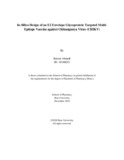| dc.contributor.advisor | Siam, Mohammad Kawsar Sharif | |
| dc.contributor.author | Ahmed, Intizar | |
| dc.date.accessioned | 2023-07-20T05:56:57Z | |
| dc.date.available | 2023-07-20T05:56:57Z | |
| dc.date.copyright | 2022 | |
| dc.date.issued | 2022-12 | |
| dc.identifier.other | ID: 18146023 | |
| dc.identifier.uri | http://hdl.handle.net/10361/18939 | |
| dc.description | This thesis is submitted in partial fulfillment of the requirements for the degree of Bachelor of Pharmacy, 2022. | en_US |
| dc.description | Cataloged from PDF version of thesis. | |
| dc.description | Includes bibliographical references (pages 38-42). | |
| dc.description.abstract | The mosquito-borne chikungunya virus has caused numerous outbreaks globally over the years
and its transmission is expeditious. Due to the lack of an effective vaccine, chikungunya infection
prevention mainly focuses on preventing mosquito bites. Chikungunya infection causes
debilitating symptoms. An effective vaccine can provide stronger protection in future outbreaks.
In this study, in-silico approach was taken to construct a multi-epitope vaccine against the
chikungunya virus and in-silico biochemical analysis of the designed vaccine was performed. The
E2 envelope glycoprotein of chikungunya virus, collected from Vipr database, was selected as
primary protein. Its antigenicity (0.5679) was found using Vaxijen v2.0. Cytotoxic T lymphocyte
epitopes, helper T lymphocyte epitopes, and B cell epitopes were identified using NetCTL-1.2,
NetMHCIIpan 4.0, and Bepipred servers respectively. The helper T lymphocyte epitopes were
screened using IFNepitope, IL-4Pred, and IL-10Pred. Linkers were used according to literature
studies in order to construct the vaccine. Biochemical analysis of the final vaccine represented
promising results. ProtParam was used to predict the instability index (35.68), grand average of
hydropathy (-0.553), and molecular weight (63.72038 kDa) of the final vaccine. AllergenOnline
and T3DB predicted the vaccine as non-allergen and non-toxic respectively. ProSAweb was
applied to assess Z-score (-5.16) and SWISS-MODEL generated Ramachandran plots. C IMMSIM predicted desirable responses of immune cells and antibodies in accordance with three
doses of the vaccine. As this study was based on in-silico computational methods, future
investigations incorporating in vitro and in vivo methods are needed to validate the safety and
efficacy of the constructed chikungunya vaccine. | en_US |
| dc.description.statementofresponsibility | Intizar Ahmed | |
| dc.format | 42 pages | |
| dc.language.iso | en | en_US |
| dc.publisher | Brac University | en_US |
| dc.rights | Brac University theses are protected by copyright. They may be viewed from this source for any purpose, but reproduction or distribution in any format is prohibited without written permission. | |
| dc.subject | Chikungunya virus | en_US |
| dc.subject | Multi-epitope vaccine | en_US |
| dc.subject | in-silico | en_US |
| dc.subject | E2 envelope glycoprotein | en_US |
| dc.subject | Biochemical analysis | en_US |
| dc.subject.lcsh | Virus chikungunya. | |
| dc.title | In-Silico Design of an E2 Envelope Glycoprotein targeted Multi Epitope vaccine against Chikungunya Virus (CHIKV) | en_US |
| dc.type | Thesis | en_US |
| dc.contributor.department | Department of Pharmacy, Brac University | |
| dc.description.degree | B. Pharmacy | |

